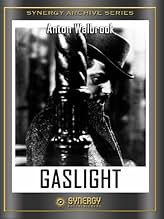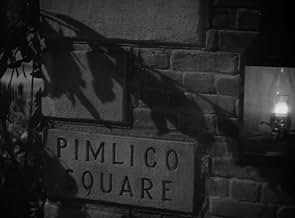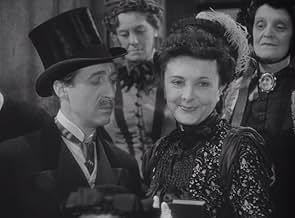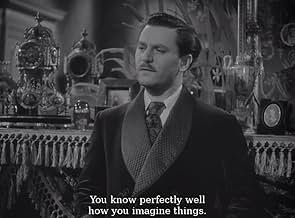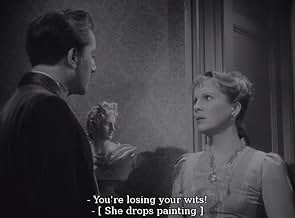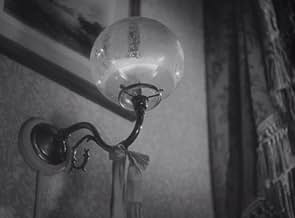NOTE IMDb
7,3/10
5,7 k
MA NOTE
Vingt ans après le meurtre d'Alice Barlow, sa maison est enfin de nouveau occupée. Cependant, le mari du couple qui a emménagé a un secret qu'il est prêt à tout pour garder caché.Vingt ans après le meurtre d'Alice Barlow, sa maison est enfin de nouveau occupée. Cependant, le mari du couple qui a emménagé a un secret qu'il est prêt à tout pour garder caché.Vingt ans après le meurtre d'Alice Barlow, sa maison est enfin de nouveau occupée. Cependant, le mari du couple qui a emménagé a un secret qu'il est prêt à tout pour garder caché.
- Réalisation
- Scénario
- Casting principal
Alfred Atkins
- Bit Role
- (non crédité)
Edwin Ellis
- Bit Role
- (non crédité)
Kathleen Harrison
- Bit Role
- (non crédité)
Katie Johnson
- Alice Barlow's Maid
- (non crédité)
Molly Raynor
- Bit Role
- (non crédité)
Avis à la une
The later version is Hollywood English, which I sometimes think is a downtown section of Hollywood Transylvanian. Believe me, the original is the real thing, from the small details up to the social assumptions: it's recognisably English. As such, the thriller is grounded in a reality that the later version can never have. And so it's scary! Of course, I admit that this justification of the original might be a lot less convincing if you're reading my words on the other side of the world...
As for the difficulty of getting hold of a copy, well every few years it's shown on one TV station or another over here, so there has to be a good copy somewhere out there.
As for the difficulty of getting hold of a copy, well every few years it's shown on one TV station or another over here, so there has to be a good copy somewhere out there.
Let's face it - the British do psychological suspense VERY well! This 1940 British production is more streamlined and suspenseful than the MGM version of 1944, as it sticks more closely to Patrick Hamilton's play. The MGM version had more 'back-story' and padding to it. I love Diana Wynyard - she was lovely to look at and seemed wonderfully edgy and vulnerable - I wasn't surprised to learn that she played the anguished mother in the West End production of THE BAD SEED - she's really only remembered today for this film and CAVALCADE (1933), but she's definitely worth watching. Anton Walbrook is a little hammier than Boyer was, and there are those obvious streaks in his hair to make him look a little older - but he has a wonderful moment at the films end when, quite suddenly, his eyes go wild and you can tell that he's completely lost his mind - might have been a nice touch if the 1944 had included such a moment. Highly recommended.
I've noticed that people seem surprised that MGM attempted to suppress the 1940 British version of GASLIGHT to avoid any competition with their version. I don't know why anyone should be surprised - Hollywood's business is a cut-throat one: remember that L.B. Mayer, along with Jack Warner and others, offered to buy CITIZEN KANE from RKO and then destroy it, all to appease William R. Hearst - fortunately they didn't (just imagine the history of film since 1941 if they had!) And although MGM didn't destroy all prints of GASLIGHT, they did manage to keep it out of sight for many years - I think I first saw it on a cable station in the early 1980s - I tuned in expecting Boyer and Bergman and got Walbrook and Wynyard - as it turned out I didn't mind at all, and have enjoyed it many times since! MGM did the same thing with Paramount's 1932 DR. JEKYLL AND MR. HYDE which, except for an occasional screening, went unseen (but much written about) until it came out on video around 1990 (under the MGM label - imagine that!)
I've noticed that people seem surprised that MGM attempted to suppress the 1940 British version of GASLIGHT to avoid any competition with their version. I don't know why anyone should be surprised - Hollywood's business is a cut-throat one: remember that L.B. Mayer, along with Jack Warner and others, offered to buy CITIZEN KANE from RKO and then destroy it, all to appease William R. Hearst - fortunately they didn't (just imagine the history of film since 1941 if they had!) And although MGM didn't destroy all prints of GASLIGHT, they did manage to keep it out of sight for many years - I think I first saw it on a cable station in the early 1980s - I tuned in expecting Boyer and Bergman and got Walbrook and Wynyard - as it turned out I didn't mind at all, and have enjoyed it many times since! MGM did the same thing with Paramount's 1932 DR. JEKYLL AND MR. HYDE which, except for an occasional screening, went unseen (but much written about) until it came out on video around 1990 (under the MGM label - imagine that!)
10preppy-3
It's easy to see why MGM locked this away in their vaults when they issued their 1944 remake--it's really great!
An evil crook (Anton Walbrook) slowly tries to drive his wife (Diana Wynyard) mad for some jewels.
This isn't as lush as the remake, but it more than makes up for it in other departments. For one thing--it's shorter by about 30 minutes and there's no romantic interlude at the beginning. This one starts dark and gets darker. Walbrook is frightening as the husband--much better than Charles Boyer in the remake. The scenes where he yells at his wife had me jumping. Wynyard is great as his fragile wife. She doesn't go into hysterics and chew the scenery like Ingrid Bergman did--she plays it calmly and quietly and very very realistically. Her final confrontation with her husband was just great. Also Cathleen Cordell is lots of fun as Nancy, the parlor maid. In the remake she was played by Angela Landsbury (in her film debut). Surprisingly, Cordell is better than Landsbury!
The remake copied this film virtually scene by scene--and suffers somewhat by comparison. It added on the unnecessary romantic subplot with Joseph Cotton. Thankfully, there's nothing like that here. This just grips you from the very beginning and doesn't let go.
Both movies are great but this one is marginally better. Very recommended.
An evil crook (Anton Walbrook) slowly tries to drive his wife (Diana Wynyard) mad for some jewels.
This isn't as lush as the remake, but it more than makes up for it in other departments. For one thing--it's shorter by about 30 minutes and there's no romantic interlude at the beginning. This one starts dark and gets darker. Walbrook is frightening as the husband--much better than Charles Boyer in the remake. The scenes where he yells at his wife had me jumping. Wynyard is great as his fragile wife. She doesn't go into hysterics and chew the scenery like Ingrid Bergman did--she plays it calmly and quietly and very very realistically. Her final confrontation with her husband was just great. Also Cathleen Cordell is lots of fun as Nancy, the parlor maid. In the remake she was played by Angela Landsbury (in her film debut). Surprisingly, Cordell is better than Landsbury!
The remake copied this film virtually scene by scene--and suffers somewhat by comparison. It added on the unnecessary romantic subplot with Joseph Cotton. Thankfully, there's nothing like that here. This just grips you from the very beginning and doesn't let go.
Both movies are great but this one is marginally better. Very recommended.
I have liked the Gaslight films for many years and was surprised and delighted recently to find both versions together on an American DVD ! Miracles will never cease, I thought!
I have read various comments from people trying to compare these two films. I will not fall into this trap - I liked each film as much as the other..true, Walbrook looks more evil as a villain than Charles BOyer, and the 1940 version is perhaps a little more picturesque with the sets ( carriages, children etc ) but both films were very well done. The picture quality of the 1944 version is obviously better than that of 1940, and I had read somewhere that they had actually tried to get the print of the 1940 version destroyed as to have only the 1944 version available. What a horrible thought that someone could actually have wanted to do that !
So, they are both great suspense films and the black and white only serves to enhance the already seedy atmosphere ! Well worth several viewings !!!
I have read various comments from people trying to compare these two films. I will not fall into this trap - I liked each film as much as the other..true, Walbrook looks more evil as a villain than Charles BOyer, and the 1940 version is perhaps a little more picturesque with the sets ( carriages, children etc ) but both films were very well done. The picture quality of the 1944 version is obviously better than that of 1940, and I had read somewhere that they had actually tried to get the print of the 1940 version destroyed as to have only the 1944 version available. What a horrible thought that someone could actually have wanted to do that !
So, they are both great suspense films and the black and white only serves to enhance the already seedy atmosphere ! Well worth several viewings !!!
What a crisp, deeply rooted thriller Thorold Dickinson created. With vile creatures (Paul) and goofy policemen and maids, we are easily captured into the world of the Mallens. Diana Wynyard does a spectacular job as Bella, giving us the right amount of insecurity coupled with fear. She is the true victim of this film and Dickinson does not let us forget that. Wynyard is nearly overshadowed by my favorite character of the film, Paul Mallen, played with so much evil by Anton Walbrook. I have seen several films in my life, and I must say that Walbrook ranks among some of the most sinister villains of them all. He has no super powers, just the ability to manipulate Bella mentally, proving that he is stronger than her. He thrives on Bella's insecurities and makes them into his greatest form of punishment. These two working together really transformed this 40s thriller into something concrete and powerful. It is the dynamic between the two that kept me glued to my seat and continually asking for more.
Coupled with the superb acting is the creativeness of Dickinson and his writer A.R. Rowlinson. Together they set the mood with darkened corners and alleyways with that constantly looming feeling that the events are going to get grittier down the road. This team made Victorian London a spooky place to visit at night. They make Bella the victim throughout this entire film, making even me wonder if she really was slowly going mad. It isn't until the end that the truth is revealed and even then we are left in suspense. It isn't until the credits roll is the film over, and that is hard to accomplish for directors of the thriller genre today. Dickinson proved that he could handle all the elements with the greatest of ease and bring them to the screen in a film that would last the test of time. I am not embarrassed to show this film to friends because I do believe that they would see the value in this production.
Grade: ***** out of *****
Coupled with the superb acting is the creativeness of Dickinson and his writer A.R. Rowlinson. Together they set the mood with darkened corners and alleyways with that constantly looming feeling that the events are going to get grittier down the road. This team made Victorian London a spooky place to visit at night. They make Bella the victim throughout this entire film, making even me wonder if she really was slowly going mad. It isn't until the end that the truth is revealed and even then we are left in suspense. It isn't until the credits roll is the film over, and that is hard to accomplish for directors of the thriller genre today. Dickinson proved that he could handle all the elements with the greatest of ease and bring them to the screen in a film that would last the test of time. I am not embarrassed to show this film to friends because I do believe that they would see the value in this production.
Grade: ***** out of *****
Le saviez-vous
- AnecdotesWhen MGM remade the film with Charles Boyer and Ingrid Bergman, the studio attempted to have all prints of this earlier version destroyed. Fortunately, several prints escaped the fire (in fact, it is believed that director Thorold Dickinson surreptitiously struck a print himself before the negative was lost).
- GaffesAfter the murder of the old lady in 1865, a police constable is shown blowing a whistle to summon assistance. Whistles were not used by the Metropolitan Police until the 1870s; prior to that they used a football rattle to attract attention.
- ConnexionsFeatured in The Kenny Report: Épisode datant du 3 septembre 2024 (2024)
- Bandes originalesThe Can-Can
(uncredited)
from "Orpheus in the Underworld"
Music by Jacques Offenbach
Arranged by Richard Addinsell
Played at the music hall and danced to by The Darmora Ballet
Meilleurs choix
Connectez-vous pour évaluer et suivre la liste de favoris afin de recevoir des recommandations personnalisées
- How long is Angel Street?Alimenté par Alexa
Détails
- Date de sortie
- Pays d’origine
- Langue
- Aussi connu sous le nom de
- Angel Street
- Lieux de tournage
- Société de production
- Voir plus de crédits d'entreprise sur IMDbPro
- Durée
- 1h 24min(84 min)
- Couleur
- Rapport de forme
- 1.37 : 1
Contribuer à cette page
Suggérer une modification ou ajouter du contenu manquant

